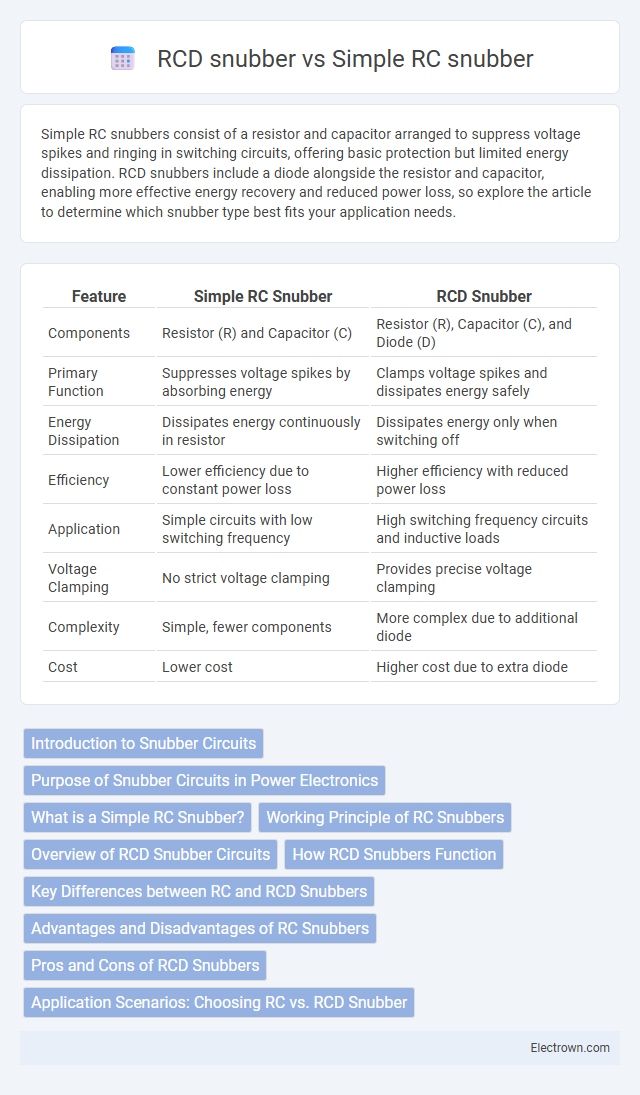Simple RC snubbers consist of a resistor and capacitor arranged to suppress voltage spikes and ringing in switching circuits, offering basic protection but limited energy dissipation. RCD snubbers include a diode alongside the resistor and capacitor, enabling more effective energy recovery and reduced power loss, so explore the article to determine which snubber type best fits your application needs.
Table of Comparison
| Feature | Simple RC Snubber | RCD Snubber |
|---|---|---|
| Components | Resistor (R) and Capacitor (C) | Resistor (R), Capacitor (C), and Diode (D) |
| Primary Function | Suppresses voltage spikes by absorbing energy | Clamps voltage spikes and dissipates energy safely |
| Energy Dissipation | Dissipates energy continuously in resistor | Dissipates energy only when switching off |
| Efficiency | Lower efficiency due to constant power loss | Higher efficiency with reduced power loss |
| Application | Simple circuits with low switching frequency | High switching frequency circuits and inductive loads |
| Voltage Clamping | No strict voltage clamping | Provides precise voltage clamping |
| Complexity | Simple, fewer components | More complex due to additional diode |
| Cost | Lower cost | Higher cost due to extra diode |
Introduction to Snubber Circuits
Snubber circuits protect your electronic components from voltage spikes and switching transients in power devices. Simple RC snubbers use a resistor and capacitor to limit voltage and dissipate energy, offering basic transient suppression and noise reduction. RCD snubbers add a diode to the resistor-capacitor network, providing improved efficiency by directing energy away from sensitive components and enhancing protection in inductive load applications.
Purpose of Snubber Circuits in Power Electronics
Snubber circuits in power electronics serve to protect switching devices by reducing voltage spikes and controlling transient energy during switching events. Simple RC snubbers primarily dampen oscillations and limit dv/dt, providing basic overvoltage protection across the switching element. RCD snubbers offer enhanced functionality by clamping voltage spikes and dissipating stored energy through a diode and capacitor, making them more effective for preventing damage in high-frequency or inductive load applications.
What is a Simple RC Snubber?
A Simple RC snubber is an electrical circuit composed of a resistor (R) and a capacitor (C) connected in series, primarily designed to suppress voltage spikes and reduce electromagnetic interference in switching devices. It absorbs transient energy generated by inductive loads during switching events, thus protecting components like transistors and thyristors from damage. Compared to RCD snubbers, which include a diode for more efficient energy dissipation, the Simple RC snubber offers a basic, cost-effective solution with limited energy handling capabilities.
Working Principle of RC Snubbers
The working principle of an RC snubber centers on mitigating voltage spikes by dissipating energy through a resistor-capacitor network connected across a switching device. The capacitor in the RC snubber absorbs the transient energy generated during switching events, while the resistor controls the discharge rate, preventing rapid voltage changes and reducing electromagnetic interference. This combination effectively smooths voltage transitions and protects components from voltage stress without the complexity of diode-based arrangements found in RCD snubbers.
Overview of RCD Snubber Circuits
RCD snubber circuits consist of a resistor, capacitor, and diode connected in a specific arrangement to protect semiconductor devices from voltage spikes by absorbing transient energy. Unlike simple RC snubbers, RCD snubbers effectively dissipate stored energy through the diode, improving efficiency and reducing power loss. Your choice of an RCD snubber can enhance circuit reliability by minimizing voltage stress and switching losses in power electronics applications.
How RCD Snubbers Function
RCD snubbers function by using a resistor, capacitor, and diode to effectively absorb and dissipate voltage spikes generated during switching events in power electronics, protecting semiconductor devices from overvoltage stress. The diode provides a path for the inductor's current when the switch turns off, allowing the capacitor to capture the spike, while the resistor dissipates the stored energy as heat, preventing oscillations. This configuration ensures reduced switching losses and improved reliability compared to simple RC snubbers, which lack the diode to control current flow.
Key Differences between RC and RCD Snubbers
RC snubbers use a resistor and capacitor to limit voltage spikes and damp oscillations, primarily reducing high-frequency noise in switching circuits. RCD snubbers incorporate a resistor, capacitor, and diode, enabling energy dissipation during both voltage spikes and transient currents, offering enhanced protection for inductive loads. Key differences include the RCD snubber's ability to clamp voltage more effectively through diode conduction and its superior performance in handling inductive energy compared to the simpler RC snubber.
Advantages and Disadvantages of RC Snubbers
RC snubbers offer simplicity and low cost, effectively reducing voltage spikes and electromagnetic interference in power circuits. They dissipate energy through a resistor and capacitor, but this leads to continuous power loss and heating, making them less efficient for high-frequency or high-power applications. Your choice of an RC snubber should weigh its ease of implementation against potential energy inefficiency and thermal management challenges.
Pros and Cons of RCD Snubbers
RCD snubbers offer superior voltage spike suppression and faster energy dissipation compared to simple RC snubbers, making them highly effective in protecting semiconductor devices in inductive switching applications. Their ability to handle higher peak currents and reduce switching losses enhances circuit reliability and efficiency. However, RCD snubbers are more complex, require additional components such as diodes and capacitors, and increase design and cost complexity compared to simpler RC snubber circuits.
Application Scenarios: Choosing RC vs. RCD Snubber
RC snubbers are ideal for circuits requiring damping of voltage spikes and oscillations in low to moderate energy switching applications, such as transistor switching in power supplies and audio amplifiers. RCD snubbers are preferred in high-energy switching environments like MOSFETs in switched-mode power supplies and inductive load switching, where efficient energy dissipation and voltage clamp are critical. Selection depends on factors like energy level, switching speed, and circuit complexity, with RC snubbers offering simplicity and RCD snubbers providing robust protection against voltage transients.
Simple RC snubber vs RCD snubber Infographic

 electrown.com
electrown.com